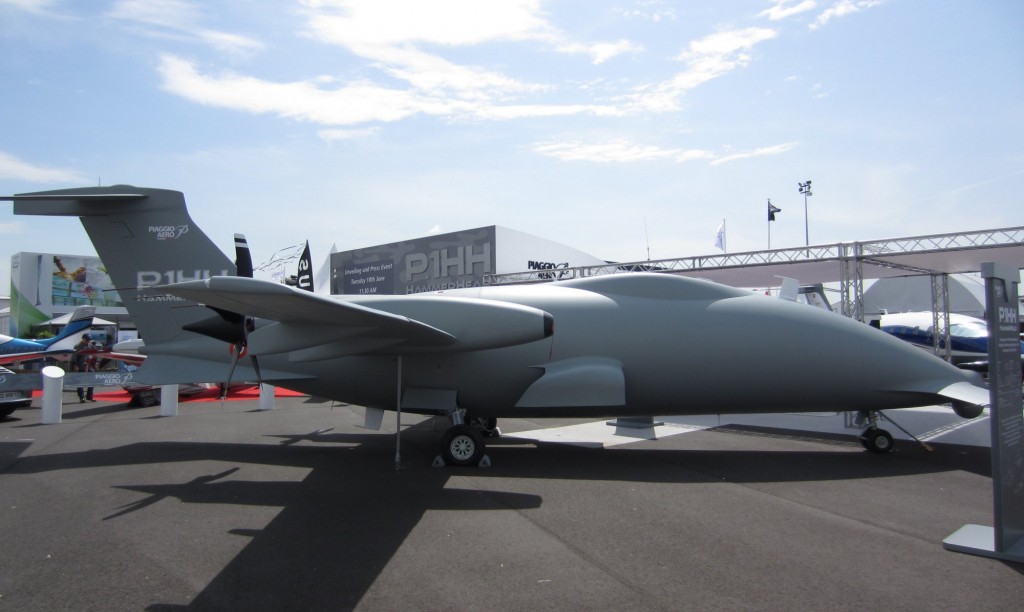 A United Arab Emirates (UAE) investment fund has beefed up its stake in Italy-based Piaggio Aero, just as the aeronautics firm gets ready for the debut flight of its P.1HH Hammerhead UAS, scheduled to take place within days at Sicily’s Trapani Air Base.
A United Arab Emirates (UAE) investment fund has beefed up its stake in Italy-based Piaggio Aero, just as the aeronautics firm gets ready for the debut flight of its P.1HH Hammerhead UAS, scheduled to take place within days at Sicily’s Trapani Air Base.
Mubadala, the US $55 billion fund set up by the Emirate of Abu Dhabi in 2002, increased its stake in Piaggio Aero from 33 to 41 percent on Nov. 12, as part of an equity increase of €190 million (US $255 million), which also saw Tata Ltd., a UK offshoot of India’s Tata Group, increase its stake from 33 to 44.5 percent.
Italian private investor Piero Ferrari has increased his stake from 1 to 2 percent, while hedge fund HDI has dropped from 33 to 12.5 percent.
That means Mubadala and Tata are now the main financial backers of development of the Italian-built Hammerhead, which is an unmanned version of Piaggio Aero’s main seller, the P.180 twin-prop business aircraft.
“The first flight will be within a week or two from Trapani,” said Alberto Galassi, the Italian CEO of the firm.
Following two years of development, the Hammerhead completed its first engine start and runway taxi in February. Testing has been shifted from Italian Air Force facilities in Sardinia, Galassi added.
“The programme has attracted the interest of the shareholders,” he said, adding that “a lot” of the new capital pumped into the firm will be devoted to continuing development of the UAS.
Like the P.180, the Hammerhead features two pusher propellors and canards on the nose. It offers a 15.5-meter wing span, maximum takeoff weight of 6,146 kilograms and will fly to 45,000 feet with 16 hours endurance, with the company claiming it can get to a target faster and stay on target longer than rivals.
Italy’s Selex ES will supply an electro-optical turret, forward-looking infrared, its e-scan Seaspray 7300 radar and mission management system.
The venture is the fruit of Piaggio’s focus on new, intelligence-, surveillance- and reconnaissance-related uses for the P.180 following the impact of the financial crisis on business flying. The firm is also working with Adasi, part of the Abu Dhabi strategic investment firm Tawazun, to produce a manned maritime patrol version of the P.180, with the UAE seen as launch customer.
One Italian analyst who declined to be named suggested Tata might sell its stake in Piaggio Aero to the UAE, leaving the Arabian Gulf state as controlling shareholder.
To meet its current UAS needs, the UAE has meanwhile purchased the export version of the General Atomics Predator A, the XP, which has been marketed to non-NATO countries.
Despite the UAE money behind the Hammerhead, the first military to show interest in the UAS has been Italy’s. Taking many by surprise, Italian procurement chief General Claudio Debertolis said at this summer’s Paris Air Show that Italy could buy 10 of the aircraft, adding that he was also tipping the UAS as a candidate for a common European medium-altitude, long-endurance program and would assist in promoting it to other countries.
The Italian Air Force is now certifying the programme and “supervising” it, Galassi said.
“We are lucky to have our shareholders; they have a strategic vision and Mubadala thinks long-term,” hesaid. “But at the same time this is a classified Italian program. The Italian Air Force will likely be the first to confirm its interest, with others to follow,” he said. “I’d call this an Italian programme.”
But the Italian Defence Ministry has not invested in the programme, creating an unusual situation in which Indian and Arabian Gulf capital is funding the development of a UAS in which Italy is certifying and showing keen interest.
“There has been interest from the UAE, but right now no request and no requirement,” Galassi said.
Italy and the UAE have discussed UAS development before. In 2009, the gulf state selected the Italian M-346 jet trainer, but the deal stalled, allegedly over problems related to a side deal on UAS.
Plans had reportedly been made to codevelop a UAS with specifications that exceeded those set down by the Missile Technology Control Regime, which restricts the sales of missiles and UAS able to carry a 500-kilogram payload at least 300 kilometers. Italy is a signatory of the treaty.
At the Paris Air Show, Debertolis said Italy would consider arming the Hammerhead, noting that the aircraft was large enough to hold weapons in internal bays and that half of what is cabin space in the manned version would remain unused.
But he added that the payload would remain within the 500-kilogram maximum set down by the Missile Technology Control Regime.
Galassi said Piaggio Aero is not yet thinking about arming the UAS.
“We are not weaponizing the Hammerhead; that is not in development now,” he said.
Source: Defense News
